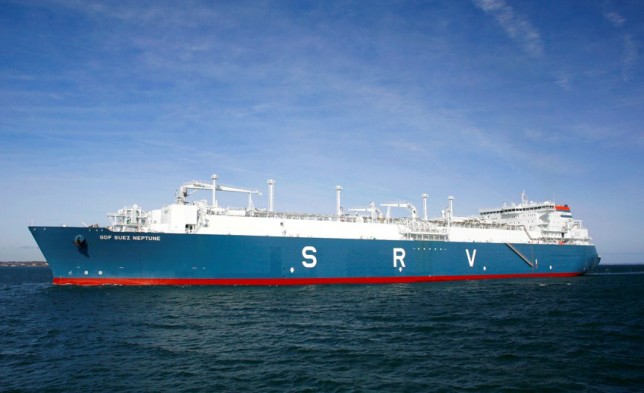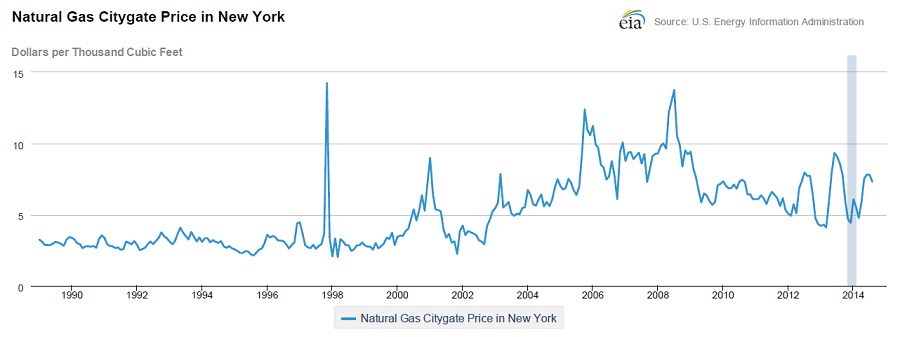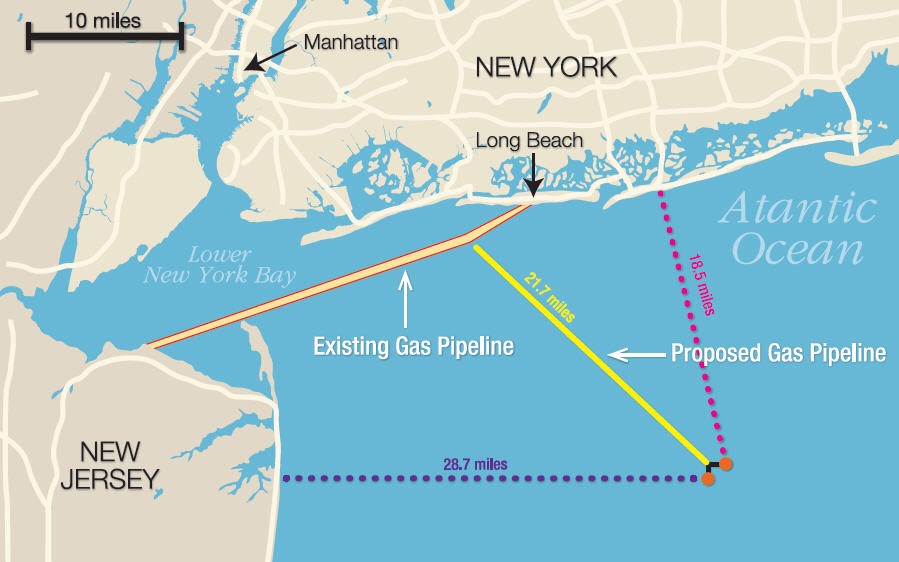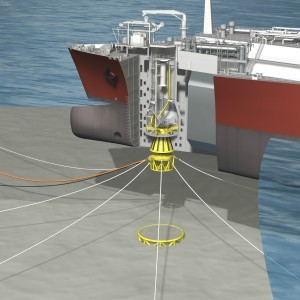The proposed Port Ambrose deepwater LNG terminal near New York City has been denounced by environmentalists as a dirty and dangerous export terminal in disguise. The reality is that LNG is the safest and cleanest fuel available and natural gas is critical in efforts to eliminate air pollution and save lives in New York City.
Protesters showed up at a public hearing January 7 on Long Island to encourage Governor Cuomo to veto the proposal for the terminal.
The Port Ambrose LNG terminal should be appreciated by environmentalists as a technological marvel that helps provide much needed seasonal supplies of clean natural gas to the New York City region, saving lives today through improved air quality, keeping utility costs down for rich and poor alike, and all in an engineering package that has the barest of ecological impacts.
The background on this project is expanding demand for natural gas in the region and constraints in the gas pipeline infrastructure that causes daily spot prices to spike with increases in demand.
New York City is currently undergoing an ambitious program to improve air quality and save lives in the region by switching out thousands of highly polluting fuel oil furnaces for natural gas furnaces. PlaNYC was begun under Mayor Bloomberg and continues under Mayor DeBlasio, and though still ongoing the project is already credited with major reductions in pollution from particulate matter (PM2.5), sulfur dioxide (SO2) and Nickel (Ni). Deaths and hospitalizations from cardiovascular and respiratory disease directly due to air pollution have also been reduced by over 20% (details and statistics). These positive environmental results stem directly from increasing the use of natural gas to replace dirty fuels.
New York City and Long Island are major natural gas demand centers that have historically suffered from pipeline constraints that cause daily spot prices to spike as demand fluctuates. The chart below from the US EIA clearly shows the price volatility.
The Port Ambrose LNG import terminal is intended to complement other pipeline improvements by providing alternative gas supply that can flexibly come and go to meet seasonal demand. Some question why an import terminal is needed at all when the USA is moving towards natural gas exports. The Port Ambrose facility is designed to meet local market needs by bringing in LNG cargo as needed to mitigate price spikes. The cargo may or may not come from abroad, depending on market conditions the LNG may be sourced from the Gulf of Mexico where the actual export facilities are being constructed.
The Port Ambrose LNG terminal will be located 18.5 miles off the coast of Long Island and connects to an existing offshore pipeline. A 21.7 mile pipeline buried under the seafloor connects to a pair of submerged buoys where a specially engineered Shuttle and Regasification Vessel (SRV) can connect and provide gas to the pipeline.
The technology that is intended for Port Ambrose is truly innovative. Unlike previous proposals for the region that involved constructing artificial islands as ports for large LNG vessels, the current proposal is an exercise in minimalism. The buried gas pipeline is connected to a buoy system that rests on the ocean floor when not in use, with only a small marker buoy visible on the surface. A specially designed ship called an SRV (shuttle regasification vessel) that carries both the cargo and the regasification equipment, connects to the submerged buoy and injects gas into the pipeline. The regasification process takes around 24 hours and in case of bad weather or emergency the SRV can disconnect and sail out to sea in 15 minutes. There are no water discharges or any kind of effluent deposited in the water at any time.
A video demonstrating the process can be seen here . Image by Hoegh LNG.
The SRV vessel itself is one of the most advanced ships ever built, capable of precise maneuvering, and uses its own LNG cargo for fuel giving it the cleanest emissions in the maritime industry. Ship based LNG facilities offer major advantages by allowing the expensive equipment to be moved in response to market conditions as well as keeping the facilities safely offshore away from population centers.
A series of charges against the Port Ambrose project have been levied by environmental protesters such as Clean Ocean Action.
Port Ambrose is a ‘Bait and Switch’ and Really a Stealth Export Project. This claim is often repeated but has no basis in fact. Export terminals are being built in other parts of the country and some US gas will likely be exported, but not from Port Ambrose. Port Ambrose is explicitly engineered and permitted to help meet seasonal demand in the New York metro region which is a major gas demand center and historically underserved. The entire pipeline infrastructure in the region is designed to bring gas in, not send gas out. Export facilities are built in areas where there is lots of supply and little demand. The claim that Port Ambrose will be re-permitted for exports is deliberate misinformation and simply not true.
Port Ambrose is Dirty and Dangerous. LNG is actually the safest and cleanest of all fuels, and the LNG industry has by far the best safety and environmental record of all common bulk fuels. LNG spills do not harm marine life because LNG floats on water and quickly vaporizes away leaving behind no residue. LNG is less volatile and less flammable than other common fuels and the safety record is reflected in insurance rates which are lower for LNG than other fuels.
Accusations that LNG tankers are highly explosive are also not true. LNG container ships are thickly insulated and extremely difficult to puncture, even by weapons. The LNG tanker industry has never experienced a loss of cargo at sea in its entire history, much less a ship explosion. And since the terminal will be nearly 20 miles out to sea, it is also hard to see how an imagined terrorist attack would lead to any damage on shore.
LNG is non-toxic and non-corrosive. LNG is simply methane, and while methane is a greenhouse gas it is common in nature and not a health threat.
Port Ambrose Displaces Renewable Energy and a Wind Farm Proposed for the Same Location. The LNG port and the proposed wind farm can coexist. The pipeline and buoy system take up minimal space and would only impact the placement of a small number of turbines. The electrical power cables from the turbines can cross the pipeline which is buried. It is the wind farm, with hundreds of turbines, each with its own foundation and cabling that has a much bigger impact on the landscape than the LNG terminal.
In the big picture natural gas and renewables work well together because gas power is easily dispatched to balance the intermittency of wind and solar. Natural gas complements and enables renewables, it does not undermine them.
Port Ambrose Would be at Risk During a Hurricane. Port Ambrose would present low risk during a hurricane because the SRV ship can be quickly moved out to sea to avoid foul weather. The gas vessels can also return quickly if needed after the weather clears. Land based facilities are more likely to be damaged in a hurricane because they cannot be moved.
During the actual Superstorm Sandy, the natural gas infrastructure in Manhattan remained functional when the electric power grid went down. The campus of NYU remained lit when the rest of the area was dark because they had their own natural gas power co-generation. Heat, hot water and power were provided to NYU and the neighborhood throughout the crisis because the gas was reliable. Natural gas is critical for distributed power generation.
It is also important to note the LNG can supply natural gas for use across all energy sectors: heat, power and transportation. Natural gas is being used today to replace dirty diesel fuel in heavy duty trucks with major benefits in air quality as well as reducing noise and odors. While electric vehicles are great for light duty transportation, heavy duty transportation will continue to rely on fuels and natural gas is the cleanest practical option. Renewable power also has little role to play in replacing furnaces for heat in large buildings, so protesters who are working to block gas pipeline developments around New York City need to demonstrate how they propose to heat Manhattan in winter, otherwise they are just defending the status quo of dirty fuel oil and diesel.
On a final note; LNG can be renewable, LNG is not always a fossil fuel. BioLNG is available today and it is one of the most promising biofuels on the market. It is conceivable that Port Ambrose could receive shipments that are partly or completely bio-based.
LNG is clean energy, Greens just don’t see it yet.
Breaking Energy, January 9, 2015 (.pdf)
The Energy Collective, January 13, 2015
Bonus Image
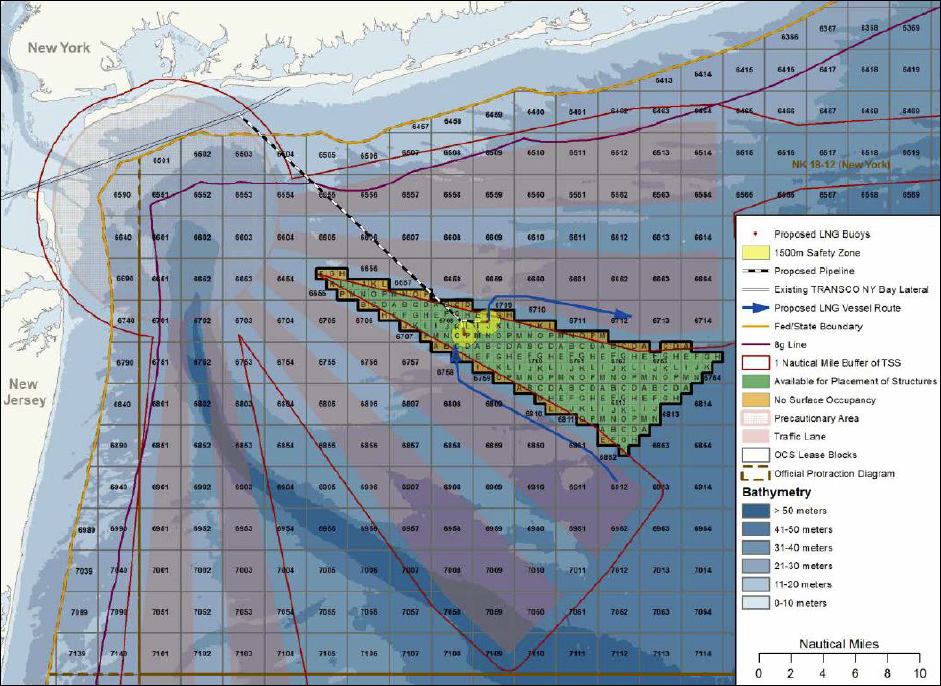 This map shows the waterway where the wind farm and lng terminals are proposed.
This map shows the waterway where the wind farm and lng terminals are proposed.
